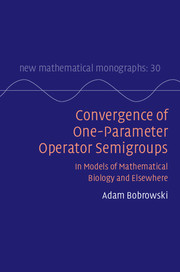Crossref Citations
This Book has been
cited by the following publications. This list is generated based on data provided by Crossref.
Bobrowski, Adam
2016.
On Hille-type approximation of degenerate semigroups of operators.
Linear Algebra and its Applications,
Vol. 511,
Issue. ,
p.
31.
Bobrowski, Adam
Kaźmierczak, Bogdan
and
Kunze, Markus
2017.
An averaging principle for fast diffusions in domains separated by semi-permeable membranes.
Mathematical Models and Methods in Applied Sciences,
Vol. 27,
Issue. 04,
p.
663.
PichÓr, Katarzyna
and
Rudnicki, Ryszard
2018.
Stability of stochastic semigroups and applications to Stein's neuronal model.
Discrete & Continuous Dynamical Systems - B,
Vol. 23,
Issue. 1,
p.
377.
Bobrowski, A.
2018.
Notes on Jan Maria Kisynski's Life and Scientific Work.
Bulletin of the South Ural State University. Series "Mathematical Modelling, Programming and Computer Software",
Vol. 11,
Issue. 3,
p.
123.
Banasiak, Jacek
and
Puchalska, Aleksandra
2019.
Mathematics Applied to Engineering, Modelling, and Social Issues.
Vol. 200,
Issue. ,
p.
439.
Gwiżdż, Piotr
and
Tyran-Kamińska, Marta
2019.
Positive semigroups and perturbations of boundary conditions.
Positivity,
Vol. 23,
Issue. 4,
p.
921.
Bobrowski, Adam
and
Rudnicki, Ryszard
2020.
On convergence and asymptotic behaviour of semigroups of operators.
Philosophical Transactions of the Royal Society A: Mathematical, Physical and Engineering Sciences,
Vol. 378,
Issue. 2185,
p.
20190613.
Banasiak, J.
and
Lamb, W.
2020.
Growth–fragmentation–coagulation equations with unbounded coagulation kernels.
Philosophical Transactions of the Royal Society A: Mathematical, Physical and Engineering Sciences,
Vol. 378,
Issue. 2185,
p.
20190612.
Bobrowski, Adam
2020.
A Note on Integrability of the Norm of a Perturbed Semigroup.
Results in Mathematics,
Vol. 75,
Issue. 3,
Gregosiewicz, Adam
2020.
Asymptotic behaviour of fast diffusions on graphs.
Semigroup Forum,
Vol. 101,
Issue. 3,
p.
619.
Carinci, Gioia
Giardinà, Cristian
and
Redig, Frank
2020.
Exact formulas for two interacting particles and applications in particle systems with duality.
The Annals of Applied Probability,
Vol. 30,
Issue. 4,
Kosztołowicz, Tadeusz
and
Dutkiewicz, Aldona
2020.
Boundary conditions at a thin membrane for normal diffusion, classical subdiffusion, and slow subdiffusion processes.
Mathematical Methods in the Applied Sciences,
Vol. 43,
Issue. 18,
p.
10500.
Kosztołowicz, Tadeusz
2020.
Boundary conditions at a thin membrane that generate non-Markovian normal diffusion.
Physical Review E,
Vol. 102,
Issue. 2,
Banasiak, Jacek
2021.
Positivity and its Applications.
p.
31.
Kosztołowicz, Tadeusz
and
Dutkiewicz, Aldona
2021.
Boundary conditions at a thin membrane for the normal diffusion equation which generate subdiffusion.
Physical Review E,
Vol. 103,
Issue. 4,
Bobrowski, Adam
2021.
Semigroup-theoretic approach to diffusion in thin layers separated by semi-permeable membranes.
Journal of Evolution Equations,
Vol. 21,
Issue. 1,
p.
1019.
Bobrowski, Adam
and
Komorowski, Tomasz
2022.
Diffusion approximation for a simple kinetic model with asymmetric interface.
Journal of Evolution Equations,
Vol. 22,
Issue. 2,
Bobrowski, Adam
2023.
Concatenation of Nonhonest Feller Processes, Exit Laws, and Limit Theorems on Graphs.
SIAM Journal on Mathematical Analysis,
Vol. 55,
Issue. 4,
p.
3457.
Budde, Christian
Dobrick, Alexander
Glück, Jochen
and
Kunze, Markus
2023.
A monotone convergence theorem for strong Feller semigroups.
Annali di Matematica Pura ed Applicata (1923 -),
Vol. 202,
Issue. 4,
p.
1573.
Zagrebnov, Valentin A.
Neidhardt, Hagen
and
Ichinose, Takashi
2024.
Trotter-Kato Product Formulæ.
Vol. 296,
Issue. ,
p.
3.



